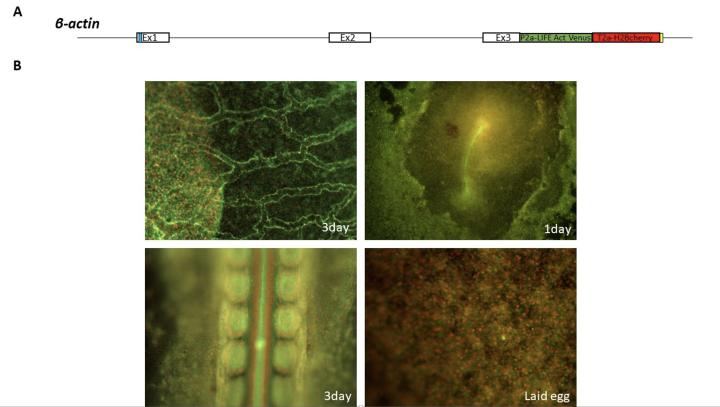ACTN (actin and nuclear markers)
Ubiquitous expression of life-act-VenusFP (1), and nuclear-cherryFP (2) transgenes
Summary & Utility
The ACTN chicken line is a powerful tool for developmental biology, facilitating studies of morphogenic movement, fate mapping and tissue grafting. The two reporter constructs (Lifact1 and H2B-cherry2) are expressed ubiquitously in early embryos and extra embryonic tissues. The ACTN line is potentially more useful than the other reporter lines as both cell membranes (Lifact) and nuclei (H2B-cherry) are distinctly labelled.

Line origin
The ACTN line was created via BBSRC funding to Professor Kees Weijer (University of Dundee). The line was generated by transfection of male primordial germ cells (PGCs) with a reporter gene targeted to the beta-actin locus. The male PGCs are carried by a sterile male surrogate host cockerel3. The surrogate male is bred to wildtype Hy-line Brown layer hens providing experimental eggs. The male PGCs are heterozygote for the insert, resulting in the provision of eggs that are 50% ACTN and 50% wildtype. The original funding for this line was provided by the BBSRC (grant numbers: BB/T006781/1, BB/T005815/1).
To reference this line for publications please contact the NARF.
Publications
-
Riedl J, Crevenna AH, Kessenbrock K, Yu JH, Neukirchen D, Bista M, Bradke F, Jenne D, Holak TA, Werb Z, Sixt M, Wedlich-Soldner R. 2008. Lifeact: a versatile marker to visualize F-actin. Nat Methods. 2008 Jul;5(7):605-7.
- Huss D, Benazeraf B, Wallingford A, Filla M, Yang J, Fraser SE, Lansford R. 2015. A transgenic quail model that enables dynamic imaging of amniote embryogenesis. Development. 142(16):2850-9.
- Ballantyne M, Woodcock M, Doddamani D, Hu T, Taylor L, Hawken RJ, McGrew MJ. 2021. Direct allele introgression into pure chicken breeds using Sire Dam Surrogate (SDS) mating. Nat Commun. 12(1):659


